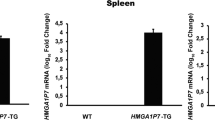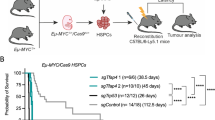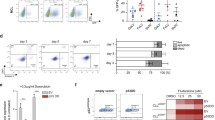Abstract
Follicular lymphoma is the most common human B-cell malignancy in the United States and Western Europe1. Most of the tumours contain t(14;18) chromosome translocations involving the human bcl-2 gene2–5. Translocation of bcl-2 sequences from chromosome 18 into the transcriptionally active immunoglobulin locus at chromosome band 14q32 in B cells deregulates bcl-2 gene expression, resulting in the accumulation of high levels of bcl-2 messenger3. Human bcl-2 transcripts generate two proteins, p26 bcl-2-α and p22 bcl-2-β, by virtue of alternative splice-site selection2. Both proteins have in common their first 196 NH2-terminal amino acids but share little similarity with other sequences in a data bank2,4. Although the biological and biochemical functions of bcl-2 are unknown, recent subcellular localization studies indi-cate that p26 bcl-2-α associates with cellular membranes, con-sistent with a stretch of hydrophobic amino acids in its carboxy terminus1,2,6. The bcl-2 gene may represent a novel oncogene having no known retroviral counterpart. Here we demonstrate the oncogenic potential of bcl-2 through a gene transfer approach.
This is a preview of subscription content, access via your institution
Access options
Subscribe to this journal
Receive 51 print issues and online access
$199.00 per year
only $3.90 per issue
Buy this article
- Purchase on Springer Link
- Instant access to full article PDF
Prices may be subject to local taxes which are calculated during checkout
Similar content being viewed by others
References
Jones, S. E. et al. Cancer 31, 806–823 (1973).
Tsujimoto, Y. & Croce, C. M. Proc. natn. Acad. Sci. U.S.A. 83, 5214–5218 (1986).
Tsujimoto, Y., Cossman, J., Jaffe, E. & Croce, C. M. Science 228, 1440–1443 (1985).
Cleary, M. L., Smith, S. D. & Sklar, J. Cell 47, 19–28 (1986).
Seto, M. et al. EMBO J 7, 123–131 (1988).
Tsujimoto, Y., Ikegaki, N. & Croce, C. M. Oncogene 2, (1987).
Gorman, C. in DNA Cloning Vol. II (ed. Glover, D. M.) 143–190 (IRL, Oxford, 1985).
Land, H., Parada, L. F. & Weinberg, R. A. Science 222, 771–778 (1983).
Land, H., Parada, L. F., & Weinberg, R. A. Nature 304, 596–602 (1983).
Scangos, G. & Ruddle, F. H. Gene 14, 1–10 (1981).
Vaux, D., Cory, S. & Adams, J. Nature 335, 440–442 (1988).
Kelekar, A. & Cole, M. D. Molec. Cell Biol. 6, 7–14 (1986).
Chen, C. & Okayama, H. Molec. Cell Biol. 7, 2745–2752 (1987).
Wano, Y., Cullen, B., Svetlik, P., Peffer, N. & Greene, W. Molec. Biol. Med. 4, 1–15 (1987).
Maniatis, T., Fritsch, E. F. & Sambrook, J. in Molecular Cloning, A Laboratory Manual, 383–389 (Cold Spring Harbor Press).
Reed, J. C., Tsujimoto, Y., Alpers, J. D., Croce, C. M. & Nowell, P. C. Science 236, 1295–1299 (1987).
Parnes, J. & Seidman, J. Cell 29, 661–669 (1982).
Author information
Authors and Affiliations
Rights and permissions
About this article
Cite this article
Reed, J., Cuddy, M., Slabiak, T. et al. Oncogenic potential of bcl-2 demonstrated by gene transfer. Nature 336, 259–261 (1988). https://doi.org/10.1038/336259a0
Received:
Accepted:
Published:
Issue Date:
DOI: https://doi.org/10.1038/336259a0
This article is cited by
-
Ammonia-induced oxidative stress triggered apoptosis in the razor clam (Sinonovacula constricta)
Environmental Science and Pollution Research (2024)
-
Identification of SPRYD4 as a tumour suppressor predicts prognosis and correlates with immune infiltration in cholangiocarcinoma
BMC Cancer (2023)
-
Applications of synthetic biology in medical and pharmaceutical fields
Signal Transduction and Targeted Therapy (2023)
-
BCL-2 isoform β promotes angiogenesis by TRiC-mediated upregulation of VEGF-A in lymphoma
Oncogene (2022)
-
MCL1 binding to the reverse BH3 motif of P18INK4C couples cell survival to cell proliferation
Cell Death & Disease (2020)
Comments
By submitting a comment you agree to abide by our Terms and Community Guidelines. If you find something abusive or that does not comply with our terms or guidelines please flag it as inappropriate.



